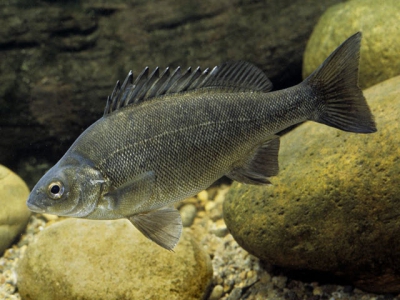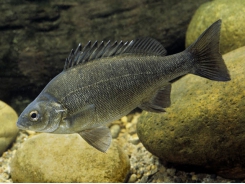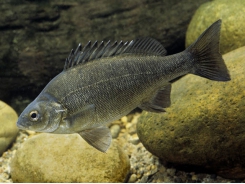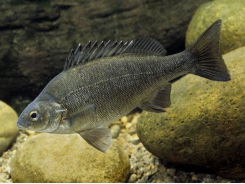Diseases of the Australian Freshwater Fish Silver Perch (Bidyanus bidyanus) - Part 7

VIRAL DISEASES
Viruses are extremely small agents comprised of DNA or RNA surrounded by protein. Viruses must invade living cells in other organisms to replicate. The study of viral diseases in fish is relatively new, and a majority of fish viruses that have been reported are from economicallyimportant species in which the diseases can cause high mortalities and severe economic losses. There are no known viral diseases affecting silver perch under culture conditions. One disease, epizootic haematopoietic necrosis, has been shown to affect the species under experimental conditions and is potentially a serious threat to silver perch culture.
Epizootic haematopoietic necrosis (EHN)
EHN is a highly infectious disease caused by the iridovirus epizootic haematopoietic necrosis virus EHNV. The virus is geographically limited to southeastern Australia. Redfin perch (Perca fluviatilis) are very sensitive to the virus, with 100% mortalities a common outcome following exposure. It is known to also affect rainbow trout (Oncorhynchus mykiss) although mortalities in trout are usually less than 4%. Under experimental conditions in the laboratory, it has been shown that exposure to EHNV seriously affects the native fish silver perch, Macquarie perch (Macquaria australasica) and golden perch (Macquaria ambigua). Outbreaks in redfin and trout typically occur when water temperatures are above 12°C in spring/summer, often involving juveniles in both species. The disease is internationally notifiable and must be reported to disease surveillance agencies. It is known from studies on redfin perch, that EHNV is readily spread in water, with infected fish shedding viral particles via body fluids and from decomposing carcasses. The virus is highly resistant to environmental degradation, likely to remain in sediments for prolonged periods, possibly utilising insects or amphibians. Iridoviruses are known for their lack of host specificity; hence many fish species may be susceptible.
Pathogen
Virus a member of the Iridoviridae family and genus Ranavirus; polyhedral virus, 150–170 nm in diameter.
Signs (in redfin and trout)
Mortalities
Slow or rapid spiralling to the surface
Erosion of fins; skin discolouration
Weak swimming; ‘headstanding’ above the bottom
Loss of appetite
Cutaneous haemorrhages (terminal stages, redfin)
Swelling of spleen and liver
Peritoneal fluid; white foci of necrosis in liver
Diagnosis
Collection of fresh and fixed liver, kidney and spleen samples; fixing of tissue for virus isolation; cell culture; ELISA followed by histopathology, immunofluorescent staining, polymerase chain reaction (PCR), electron microscopy and/or other tests.
Treatment
No known treatment; strict quarantine to prevent spread; cleaning and disinfection (200 mg/L sodium hypochlorite for 2 h); proper carcass disposal.
Prevention
Exclusion of wild fish and ornamental fish, particularly redfin perch from ponds, drains and the farm’s water source; reduction in stocking levels; maintain good water quality (particularly trout); regular cleaning and disinfection of gear; exclusion of piscivorous birds.
Miscellaneous noninfectious diseases, disorders and conditions
HYPOXIA (LOW DO)
DO is the most limiting water quality variable in intensive aquaculture, and is closely linked to fish health. There have been significant losses of silver perch following acute hypoxia in ponds, as well as tanks and in purging and transport systems. Fish mortalities associated with low concentrations of DO have occurred following inadequate or failed aeration (particularly during summer), ‘crashes’ of algal blooms, and chemical treatment using formalin or copper sulfate in ponds. Generally, silver perch ‘gasp’ at the surface when DO decreases to 2 mg/L or less. Subjecting fish to prolonged chronic hypoxic conditions (<3 mg/L DO) will cause stress, reduce feeding and feed assimilation, and result in poor growth.
Chronic hypoxia can predispose fish to opportunistic infections. Even relatively short periods (minutes) of low DO can cause skin necrosis and secondary bacterial infections in subsequent days or weeks.
Signs
Fish ‘gasping’ at water surface, particularly early morning
Fish congregating at water inlets or near edges
Largest fish dying first
Acute mortality
Dead fish having pale appearance and blotchy skin (Figs. 90, 91 and 92)
Rapid decline of feeding response (particularly tanks)
Darkening of skin and inactivity (tanks)
Open mouth and flared opercular

Diagnosis
Regular observation of fish and ponds. Routine daily monitoring of DO (early morning) using a high quality calibrated meter.
Treatment
Provide emergency water exchange (including from other ponds having higher DO levels) and supplemental aeration (2nd aerator and/or tractor powertakeoff aerator)
Prevention
Provide adequate aeration (maintain DO >4 mg/L early morning) and emergency power backup; avoid formalin or algacide treatments above 25°C water temperature and provide continuous 24 h aeration for 4–5 days following treatments; avoid overcrowding, excessive stocking densities and wasteful feeding; reduce feeding during periods of high water temperature (>28°C); provide oxygen (bottled) during harvest procedures and transport and in RAS.
HYDROGEN SULPHIDE POISONING
Hydrogen sulphide (H2S) is a gas that is produced during the anaerobic breakdown of organic matter by bacteria. It is commonly known as ‘rotten egg gas’ due to its strong, distinctive and pungent smell. There have been several cases of high mortalities of silver perch in ponds and tanks, where H2S poisoning has been suspected. H2S is toxic at low concentrations (e.g. levels should be <0.003 mg/L) and can cause rapid death with few, if any, diagnostic signs.
Problems have occurred in poorly aerated ponds following the disturbance of bottom sediments during harvest procedures (Fig. 93). Some sources of bore water are naturally high in H2S. The use of bore water that has been lying stagnant and/or the use of poorly flushed water delivery lines have also caused fish mortality in tanks. H2S interferes with fish respiratory mechanisms causing hypoxia.

Signs
Acute mortality following sediment disturbance or water exchange
Erratic swimming around pond edges
Rapid breathing, then listlessness and death
Schooling at water inflows
Redness in fins and tails
Diagnosis
Smell of ‘rotten egg gas’ may be indicative of a problem. Water sample collection (2 litres, sealed underwater) and testing by a qualified laboratory; sample can be refrigerated and stored following preservation with zinc acetate and sodium hydroxide (to >pH 9)
Treatment
Ponds:
Vigorous aeration of water using surfacespray type aerators; rapid water exchange; the addition of potassium permanganate to oxidise H2S.
Tanks:
Use packed column degassers; lowering temperature and increasing pH will decrease H2S toxicity.
Prevention
Maintain aerobic conditions using appropriate aerators and aeration regimes; use of aerators that provide both oxygen and create currents will reduce stagnant areas of water; remove objects (e.g. rocks, tyres, cages) from ponds that cause sediment buildup and poor water flow; regularly dry, desilt and till ponds to oxidise sediments; flush water lines and position footvalves of pumps well above bottom sediments.
GAS SUPERSATURATION (Gas Bubble Disease)
There have been several reports of losses due to gas supersaturation, but it does not represent a significant problem in the silver perch industry. There are no confirmed reports of gas bubble disease associated with nitrogen, but supersaturated levels of DO (160%) have been associated with the formation of gas emboli in the tails and gills of silver perch (Fig. 94). Large blooms of unicellular algae or extensive growth of macrophytes in ponds in summer may result in supersaturated levels of DO through excessive photosynthesis at high water temperatures and still weather conditions.

Signs
Fish surfacing then diving (particularly in shallow water) Gas emboli in fins and/or eyes
Oedema of secondary gill lamellae
Exophthalmia (‘popeye’)
Formation of bubbles on objects placed in water
Diagnosis
Macroscopic examination of fish; gas emboli in fins; ability to squeeze gas bubbles from the skin while the fish is held underwater; microscopic examination of gill, 100×; presence of gas emboli (Fig. 95).
Treatment
Ponds:
Aeration of pond for >1 h each day for several days using surface aerators (e.g. paddlewheels) will allow the gas to equilibrate with the atmosphere; water exchange.
Tanks:
Most likely nitrogen gas (not oxygen) caused by saturation of bore water or ingress of air under pressure via faulty pumps; excess gas can be stripped using a packed column degasser.
Prevention
Maintain daily aeration using paddlewheel or other surface splashing aerators; in smaller ponds, troublesome algal blooms in smaller ponds can be diluted using water exchange or use of an algacide (e.g. copper sulfate). Ensure pumps and associated plumbing have no leaks; use packed column degassers to strip excess gas; maintain fish transport tanks around 100% oxygen.
Related news
Tools

Phối trộn thức ăn chăn nuôi

Pha dung dịch thủy canh

Định mức cho tôm ăn

Phối trộn phân bón NPK

Xác định tỷ lệ tôm sống

Chuyển đổi đơn vị phân bón

Xác định công suất sục khí

Chuyển đổi đơn vị tôm

Tính diện tích nhà kính

Tính thể tích ao




 Diseases of the Australian Freshwater Fish Silver Perch…
Diseases of the Australian Freshwater Fish Silver Perch…  Diseases of the Australian Freshwater Fish Silver Perch…
Diseases of the Australian Freshwater Fish Silver Perch…